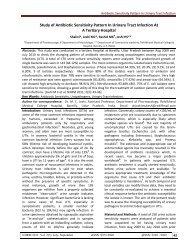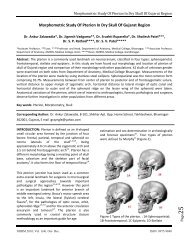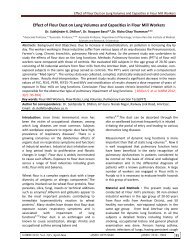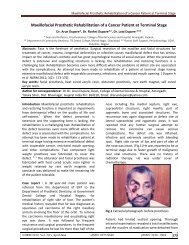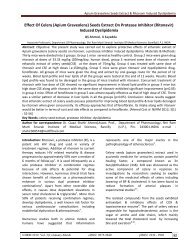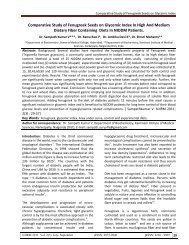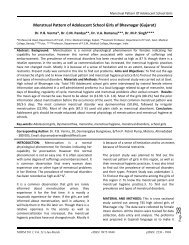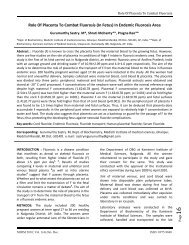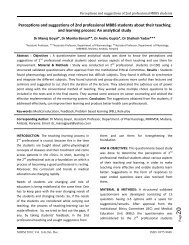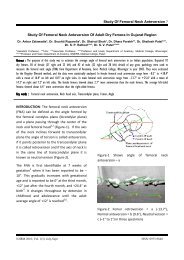Study Of Carrying Angle 28 - njirm
Study Of Carrying Angle 28 - njirm
Study Of Carrying Angle 28 - njirm
Create successful ePaper yourself
Turn your PDF publications into a flip-book with our unique Google optimized e-Paper software.
Table‐2 Shows comparison of average<br />
carrying angle in male and female by<br />
workers and present study<br />
<strong>Study</strong> by <strong>Carrying</strong><br />
angle –<br />
Male<br />
<strong>Carrying</strong><br />
angle –<br />
Female<br />
Potter 8<br />
6.83° 12.65°<br />
Baughman et al 9 11.0° 15.0°<br />
J Rai et al 10<br />
13.26° 17.91°<br />
Keats et al 11<br />
11.0° 13.0°<br />
G. N. Khare 12<br />
13.56° 16.92°<br />
Present <strong>Study</strong> 6.9° 11.8°<br />
Table‐1 shows values in range, mean and<br />
standard deviation of the carrying angle,<br />
length of forearm and height. The average<br />
carrying angle of male is 6.9° and of female is<br />
11.8° in present study. Results obtained in<br />
present study are quiet comparable with<br />
results of other workers study.<br />
Results obtained by Potter 8 and present study<br />
are almost similar. From the above study we<br />
have observed that the carrying angle in<br />
female is greater than male. In the present<br />
study 63.3 percent of female height ranges<br />
between 150–160 cm, average 153.9 cm,<br />
where as major population among male<br />
students (61.3%) height vary form 160 – 170<br />
cm, average 166.8 cm.<br />
Average Right forearm length is 24.96 cm in<br />
male and 22.70 cm in female whereas on the<br />
left side this value is 24.96 cm in male and<br />
22.68 cm in female. Difference of the length<br />
of forearm of right and left side is statistically<br />
insignificant, whereas difference in the length<br />
of forearm in the male and female is<br />
statistically significant. From the present<br />
study, it is observed that the height and<br />
forearm length both are more in males than<br />
females. In contrast to this average carrying<br />
angle is more in females than males. We have<br />
proposed a new explanation for greater<br />
carrying angle in females than in males. When<br />
the forearm is pronated the proximal part<br />
angulates. The medial part of the trochlear<br />
<strong>Study</strong> <strong>Of</strong> <strong>Carrying</strong> <strong>Angle</strong> 30<br />
notch moves more away from the humeral<br />
articular surface than the lateral part.<br />
Therefore the medial flange of trochlea is not<br />
compressed & grows more than lateral flange.<br />
If the height of a person & therefore length of<br />
ulna is lesser, then because of shorter lever<br />
arm, the proximal end has to angulate more<br />
in order to bring the hand in pronated<br />
position for routine work. Therefore in a<br />
shorter person the medial part of trochlear<br />
notch of ulna goes more away from the<br />
medial flange of trochlea which can now grow<br />
more than in a person with longer forearm,<br />
leading to greater carrying angle.<br />
The carrying angle develops in response to<br />
the pronation & is dependent on the length of<br />
the forearm bones greater the length of the<br />
forearm bone lesser is the angulation of<br />
proximal articulation of proximal articular<br />
surface, therefore lesser is the carrying angle<br />
(Figure‐2). From the present study it is clear<br />
that the height & length of the forearm are<br />
directly related to each other. Length of the<br />
forearm in female is 22.7 cm on right side and<br />
22.6 cm on left side where as in male this<br />
value is 24.9 cm on both sides which is<br />
inversely related to the carrying angle (Figure‐<br />
3).<br />
Figure‐2 Scattered diagram showing<br />
correlation between height and carrying angle<br />
Olecranon‐coronoid angle exhibiting high<br />
sexual dimorphism may be one of the causes<br />
of sexual dimorphism observed in carrying<br />
NJIRM 2010; Vol. 1(3). July-Sept. ISSN: 0975-9840



